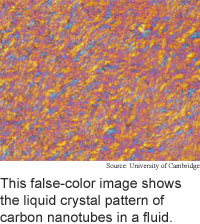
Nanotube mix makes liquid crystal
Researchers from the University of Cambridge
in England have found that carbon nanotubes can be mixed with a solvent
to form a liquid crystal.
Carbon nanotubes are rolled-up sheets of carbon atoms that can
be as narrow as 0.4 nanometers, or the span of four hydrogen atoms. They
have useful electrical and mechanical properties and are a leading player
in nanotechnology.
Liquid crystal forms an ordered structure like a crystal along
one dimension, but acts like a liquid in the other two.
The researchers' method opens the possibility of processing materials
made from carbon nanotubes in ways similar to those used for existing
materials like rigid chain polymers, or plastics. Carbon nanotubes may
eventually enable ultrasensitive sensors, super-dense computer memory,
and molecular-scale electronics.
The researchers' method also provides a way to more closely examine
the structure of the liquid crystalline state. Liquid crystals are commonly
used in computer displays.
Nanotube liquid crystal could be used in practical applications
in five years, according to the researchers. The work appeared in the
November 21, 2003 issue of Science.
Ethanol yields hydrogen
Biochip makes droplet test tubes
Model keeps virtual eyes right
Simple optics make quantum relay
Briefs:
Hot tip boosts disk capacity
Nanotubes boost shape recovery
Nanowires spot DNA mutation
Scans pick up object orientation
Nanotube mix makes liquid crystal
Film promises terabit storage

Research Watch blog
View from the High Ground Q&A
How It Works
RSS Feeds:
News
Ad links:
Buy an ad link
Ad links: Clear History
Buy an ad link
|
TRN
Newswire and Headline Feeds for Web sites
|
© Copyright Technology Research News, LLC 2000-2010. All rights reserved.